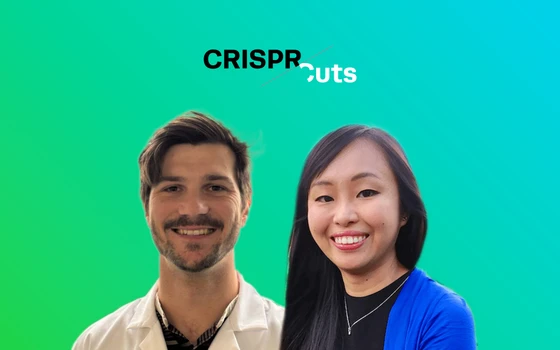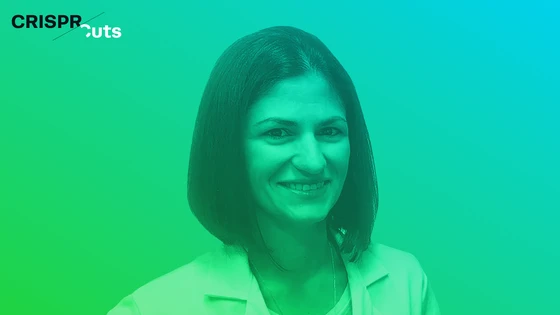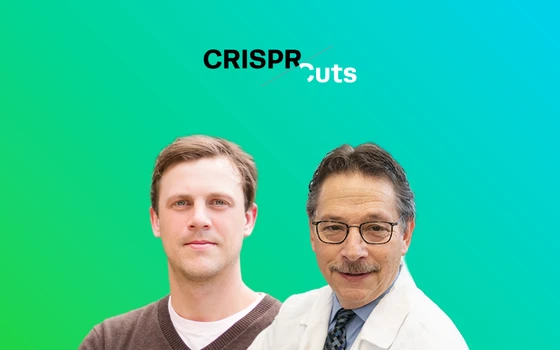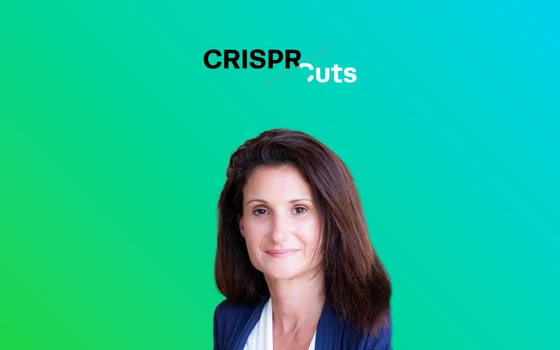Contents
CAR T cell therapy advancements using CRISPR were one of the CRISPR breakthroughs of 2018 that we told you to watch out for. Though CAR T is still in the clinical stage, it is one of the most promising breakthroughs in the treatment of cancer.
Dr. Avery Posey, Jr. is a researcher from Maryland, currently working out of the University of Pennsylvania. He studied genetics at the University of Chicago and worked as a post-doc at the University of Pennsylvania with Dr. Carl June, who is an expert in T cell engineering and cancer immunotherapy.
Dr. Posey’s lab focuses on CAR T therapies and other immunotherapies to advance the fight against cancer. Specifically, they are doing this based on the sugars that may be different on a tumor cell from the ones one might find on a normal cell. As part of our CRISPR Cuts podcast series, we sat down with Dr. Posey to learn more about his research team, and what’s going on in the world of CAR T. To get in touch with Avery, you can find him on LinkedIn.
We have transcribed our discussion, and included some extra information to help you learn all about CAR T immunotherapy. Tune in to the podcast or read our breakdown of the interview (plus extra info) below. The choice is yours!
How CAR T Technology Works
Chimeric Antigen Receptor (CAR) T cell therapy involves using patient's own cells as the source of treatment. Cells are harvested from the cancer patient, engineered and turned into CAR T cells, and then transplanted back in the patient, killing their cancerous cells.
In more detail: CARs are chimeric proteins that allow T cells to target cancerous tumors. Cells from the cancer patient are harvested and engineered to express the CAR protein on the cell membrane that recognizes specific antigen on tumor cells. The cells are then transplanted back into the patient, now with the ability to seek and destroy the cancerous tissue.
If you want the full detailed science behind this amazing technology, check out our full article on how CAR T therapies and CRISPR are fighting cancer.
In the field of medicine, this is a revolutionary breakthrough, as studies have thus far demonstrated that this form of therapy is not toxic to the patient, unlike chemotherapy. Though it is not completely devoid of possible side effects, CAR T therapy does not harm the patient’s organs the way that chemotherapy does, making it a much better cancer treatment alternative.
5 Key Takeaways From This Podcast
Though a lot was covered in our talk with Dr. Avery Posey Jr., here are the main highlights related to CAR T therapy and its progress as a viable medical treatment.
CAR T therapy has shown complete ablation of a patient’s tumor in as little as 10 daysWhen it comes to cancer treatment, this rate of success is astounding. It is not the case for every patient, but demonstrates the effectiveness of this treatment.
Time in podcast: 6:00
When it comes to cancer treatment, this rate of success is astounding. It is not the case for every patient, but demonstrates the effectiveness of this treatment.
Time in podcast: 6:00
2. CRISPR has the potential to make CAR T even betterCRISPR can help CAR T with its targeting of cancer cells, which would increase its effectiveness even more; this increase in effectiveness could also mean a reduction in costs. CRISPR also has the potential to help CAR T go from an autologous to an allogeneic therapy.
Time in podcast: 8:20
CRISPR can help CAR T with its targeting of cancer cells, which would increase its effectiveness even more; this increase in effectiveness could also mean a reduction in costs. CRISPR also has the potential to help CAR T go from an autologous to an allogeneic therapy.
Time in podcast: 8:20
3. CAR T therapy is a less toxic and safer treatment for cancer than chemotherapyBecause of its lack of side effects including harm to vital organs and hair loss, CAR T does not have the same toxic impact on patients that chemotherapy does. It provides a more natural, safer alternative.
Time in podcast: 11:00
Because of its lack of side effects including harm to vital organs and hair loss, CAR T does not have the same toxic impact on patients that chemotherapy does. It provides a more natural, safer alternative.
Time in podcast: 11:00
4. There are over 300 ongoing clinical trials for CAR T, targeting some of the most prevalent cancersThe CAR T technique targets cancerous tumors, which cause over 80% of cancer-related deaths. These include cancers of the brain, pancreas, prostate, breasts, ovaries, colon, lungs, and more.
Time in podcast: 16:35
The CAR T technique targets cancerous tumors, which cause over 80% of cancer-related deaths. These include cancers of the brain, pancreas, prostate, breasts, ovaries, colon, lungs, and more.
Time in podcast: 16:35
5. CAR T treatments will be very expensive, but offer much better success rates than other therapies
The price tag for a one-time treatment lands in the $300,000-$500,000 range; however, some companies are so sure of its success, they are offering patients their money back if the treatment doesn’t work within 30 days.
Time in podcast: 24:30
Now that you’ve got the main points down, here’s a little about the history of CAR T, and how it got to the successful point it’s currently at today.
The price tag for a one-time treatment lands in the $300,000-$500,000 range; however, some companies are so sure of its success, they are offering patients their money back if the treatment doesn’t work within 30 days.
Time in podcast: 24:30
Now that you’ve got the main points down, here’s a little about the history of CAR T, and how it got to the successful point it’s currently at today.
CAR T Cell Therapy and Research: 30 Years in the Making
This revolutionary science didn’t come out of nowhere. T cell research has been going on for over 30 years, and still has a way to go. Learn more about its history and what’s left to discover.
Minu Prabhune: I think the field of immunotherapy is very interesting, and we have been hearing a lot about CAR T cell therapy, particularly for treating cancer. Could you give us a little bit more background on why it wasn’t used before or why has it recently come into focus?
Avery Posey, Jr.: As with all scientific research, it takes a long time to get to something that's clinically relevant. CAR T cells have been studied and worked on for the last 30 years. They are just now making it to the clinic because there were a lot of advancements that needed to happen before we could get into human trials.
We had to learn how to grow human T cells outside of the human body. That took a lot of effort from many different institutions and investigators. We had to learn how to use viral vectors that are similar to some of the pathogenic viruses that we have in human disease, like a genetically-modified version of HIV. And we had to learn how to use that safely so it doesn't cause disease, and we can use it to our advantage to make a cell do what we want it to do.
And then we had to learn how to develop these molecules specifically so that they have a long-term effect. There were first generation strategies of CARs that were developed that could work in a petri dish in a laboratory, but they didn't work well in our mouse models, and they didn't work well in humans because we hadn't learned yet how to make them last for a long time. Now we have finally gotten to that stage; 30 years after the first CARs were reported in the scientific literature. Presently, we're at a point where the FDA has approved use of this technology to treat certain diseases, pediatric acute lymphoblastic leukemia and Adult Diffuse Large B-Cell Lymphoma.
How CAR T Therapy Works for Cancer Patients
How exactly does T cell therapy help patients looking for treatment for their cancer? How would they access this therapy, and how will it help them?
Kevin Bryant: I think a lot of people might have heard of CAR T therapy in general, but I think relatively few people really understand what it is and how it works. Would you mind elaborating a bit more on that? Maybe start with how it would work in the clinic. For example, you have someone that is going to receive CAR T therapy. What's the process? What happens? And how does that work to attack their cancers?
Avery: This is a relatively simple process now. How this happens clinically is that a patient would come into one of the major medical hospitals that are using this technology. Then, the patient is apheresed, a significant amount of blood is drawn, and the patient's white blood cells are collected.
Depending on the treatment that they are receiving, the cells are either frozen or shipped directly to a manufacturer, and that manufacturer does all of the work to make the CAR T cells. They activate the T cells, treat them with a virus that turns them into CAR T cells, and they expand them in a very clean, safe laboratory; this is what's called GMP production.
Once those cells become CAR T cells, they are frozen and shipped back to the hospital. The patient can then go into their local hospital, receive their CAR T cells, and then they need to be monitored for a certain period of time afterward.
The success rate of these cells showed complete ablation of a patient's tumor in as early as 10 days. That's not the case for every patient, but that shows you the power of these cells compared to other cancer therapies.
How CRISPR Will Accelerate CAR T Cell Therapy
Where does CRISPR genome editing fit in to this equation? Learn more about how CRISPR can make CAR T more effective by improving its targeting ability.
Minu: I find it really interesting that now we are at a point where you can actually go into a clinic and have your cells edited and inserted back. As you mentioned before, this has taken a long time - over 30 years. Of course, along with the efforts of researchers, one important part of CAR T is the advancements in technology. So, do you think technologies like CRISPR have accelerated this process, bringing us to the clinic faster?
Avery: I think that in the next generation CAR T cell therapies that we will see, CRISPR will definitely have a role.
The format of the CAR T cell therapy is autologous. That means that they come from patient A, they are manufactured from patient A's cells, and they go directly back into patient A. They can never be used to treat patient B, because any T cells from patient A would recognize patient B as a foreign system, and would attack patient B.
It's important for accessibility to be able to have CAR T cells that are universal or ‘off the shelf’ so that they can be used to treat patient A, B, C, and D. To do that, we have to be able to edit T cells so that they lose the ability to transfer diseases from patient A to patient B. We have to limit their ability to recognize another individual as foreign, and to do that, we need gene editing technologies like CRISPR. CRISPR would be key to moving from an autologous therapy to an allogeneic therapy - something that's very universal.
And this is very important, in particular, for cancer patients, because it can sometimes be difficult to manufacture healthy CAR T cells from a patient who has been treated previously with very strong chemotherapies that have weakened their immune system. So if we take weak cells from a patient and try to engineer them into a powerful cancer therapy, they may not work as intended for every patient.
We think that we can actually engineer better cancer therapies with CRISPR than with the current first generation of manufacturing.
Why CAR T Immunotherapy is a Better Cancer Treatment Than Chemotherapy
Chemotherapy is a very toxic treatment when compared to CAR T immunotherapy. Learn more about how their effect on the human body is different.
Minu: You mentioned chemotherapy, which is probably the most well-known, or only known method for cancer treatment by most people, so could you comment on how immunotherapy is better, or why is it a more exciting approach when compared to chemotherapy or any other existing cancer therapies?
Avery: One of the major benefits of improvements in cancer therapy actually has been our ability to have something more targeted. And we saw this with some of the small molecules previously that we could target a drug specifically to a tumor and not cause general toxicity in all fast-growing cells in a person. We see that toxicity overtly when you see a cancer patient's hair fall out, but there are many other changes that are happening inside of that patient because of the chemotherapy.
Chemotherapies in general limit growth and kill fast growing cells. That works well for tumors, but that can also affect many normal vital organs, making it a very toxic therapy. We are finally getting to a point where we are moving away from chemotherapy and moving towards something that can be considered more natural. Although it's difficult for many people to consider CAR T cells natural since we are actually genetically modifying them, they do start as T cells from a patient. They are naturally arising, then they are modified into a cancer therapy.
We are seeing a cancer drug being made from a person's own cells that did not cause disease in that person before, and did not cause toxicity in that person before. So, if our modifications don't go on to cause toxicity - and that's something that the field definitely has to work on and be very conscious about - then we are actually improving on the safety profile of cancer therapies by using immunotherapies.
In addition, these immunotherapies have the potential to reject or eradicate large masses of tumors, and we have seen this with many different modalities of immunotherapies. Probably the most well known or exciting areas of immunotherapy now that are very accessible to patients are immune checkpoint blockades. These are antibodies that can bind to molecules like PP1 and CTLA-4 that are known to inhibit the immune system (which tumors take advantage of).
There are new drugs that can block the activity of those inhibitory receptors, so called ‘cutting the brakes’ on the immune system and allowing reactivation or activity of that immune system to happen again and attack the tumor. Those immunotherapies are very exciting because, arguably, in a low percentage of patients (20 to 30%), there are significant responses where very large masses of tumors are being eradicated. Those therapies work by releasing a general block on the immune system.
Where CAR T cells can be improved and can improve on those modalities, is that we can actually target a T cell specific to the tumor, and only in those T cells can we remove those blocks and activate those specific T cells that are targeted towards a tumor.
That will improve on the safety profiles of immunotherapies as well, so some of the checkpoint blockade molecules have some related toxicities, because if you generally over-excite the immune system, you can start to cause autoimmune diseases that will go along with the anti-tumor responses in the patients. So many of these patients receive treatment and then start to develop things like psoriasis or diabetes, or cardio-toxicities associated with the checkpoint molecules and those antibody-based immune therapies.
CAR T cells may be able to improve on those toxicities by directly targeting the tumor and only activating specifically those T cells that are tumor-specific.
CAR T Clinical Trials: What’s Going On Now?
CAR T is still in the clinical trial stage. Here’s an update on what trials have been done, which are currently in progress, and how far away we are from CAR T being available to the general public.
Kevin: I think it's really hard to overstate how important this kind of science is, and how much of an impact CAR T therapies are going to make in our lives. It's literally going to change how we think of medicine.
You talked about this a bit already, this technology was a long time coming, but lately it seems like it's moving pretty quickly. These therapies are already in the clinic, and there are trials underway. We know that UPenn in general is involved in several of these as one of the first hospitals that has started clinical trials, and your group in particular is involved in this area. Can you tell us a little bit more about the clinic trials that are currently underway and any others that are sort of in the planning stages?
Avery: There are over 300 clinic trials using CAR T cells registered on ClinicTrials.gov, and they primarily take place in two countries: the United States and China. There is lots of work being done such as chronic lymphocytic leukemia, or acute myeloid leukemia, and multiple myeloma, and there is lots of excitement surrounding that.
There are also many companies in the field that are currently working on this. As you mentioned, UPenn was one of the first institutions to run clinic trials in CAR T cells, and there was a very impactful report of the first three patients treated with this technology developed at UPenn in 2011 which made a very significant impact in the field. After that breakthrough, we saw a dramatic growth in the involvement from others.
But what we are really excited about is the use of CAR T cells against many of the solid tumors that are known to cause over 80% of cancer-related deaths. These are pancreatic cancers, brain cancers, prostate cancers, breast cancers, ovarian cancers, colorectal cancers, and lung cancers. We are very interested in the results of those trials, and are following them intensely. Some of these trials have been run out of the University of Pennsylvania, including a CAR T cell trial for brain cancer, a CAR T cell trial for prostate cancer, and one for pancreatic cancer. Next year, we are hoping to open a new trial for breast and ovarian cancers as well. We are looking for some evidence of CAR T cells working in these tumors similar to how they've worked in some leukemias with such great success.
Companies Involved in CAR T Research
Get insight on how private companies are helping take CAR T from the research phase to the trial phase to being available as a treatment in hospitals.
Kevin: You mentioned the involvement of some companies in these trials. Can you talk a little bit more about how that works? Do a lot of these studies start in an academic lab and then receive support from a company to bring them through the clinical trial stage? Can you tell us a little bit more about how that process works?
Avery: So a lot of research and development occurs in academia, but academia is not well-suited to take a significant finding in a laboratory and small clinical trials all the way through the trial networks needed to receive an FDA approval, so it's definitely important that we collaborate with large and small pharmaceutical companies who have the ability to take these therapies forward so that they can be available for patients as soon as possible.
There have been quite a few cases of significant investments from pharmaceutical industries in some of the academic labs that are developing CAR T cells to take those further - beyond that one institution - into the clinic, and this is a very exciting field. There is also a lot of excitement from investors to take CAR T cells to the clinic.
CAR T Regulations: China vs. the U.S.
How do regulations surrounding this treatment differ in the United States compared to China - the two main countries working on CAR T in the clinical trial stage?
Kevin: You mentioned that a lot of the clinical trials take place mainly in in the United States and in China, and I am sure you've seen the news recently that there's a report out of China that there may have been the first babies born that were edited with CRISPR. Do you want to comment on any of the science that is going on in China, for example, how it might be different than the stuff here in the states?
Avery: China is a very interesting country because there is a large scientific workforce that is well-trained and equipped with lots of technologies, similar to the United States. China however, has the ability to move a lot faster than the United States, mainly because there is less federal regulation surrounding the beginning of a clinical trial. From what I can understand from talking to colleagues in China, the regulation necessary to start a clinical trial is merely approval from that specific hospital in which the clinical trial will be run.
I think having less regulation to start a clinical trial is important, but we also have to be very careful about the safety and ensure that we are maintaining the highest level of patient safety. Regulation in terms of patient safety is important, but I do think that the United States needs to get a little better at getting clinical trials to start faster, so it's very exciting to see some of the work in China proceed so expediently.
And though it's exciting to see the speed at which China can move a technology forward, it's also very important to ensure that we're still working ethically in these cases, and from my understanding, this specific instance was not an ethical use of scientific technology.
Minu: You are absolutely right about the regulations; we need that for safety, but at the same time, we also need to make sure that technology is not stalled simply due to regulatory procedure, and that’s one of the main holdups right now.
Will CAR T Therapy Be Accessible to the General Public After Clinical Trials?
How close are we to getting this therapy in hospitals for cancer patients?
Minu: When a clinic trial or a therapy goes through and passes, how accessible would it be to the general public? Would they have to pay a lot to get that or would it be as common as any other drugs? Would you like to comment on that?
Avery: Sure. This is not my field, but the pricing and marketing of pharmaceutical drugs is a very interesting area that I think requires expertise from a lot of different areas, including politics.
CAR T cells at this point are very expensive, and there is a lot of discussion around whether insurance carriers will cover these therapies, even if there are other therapies that are more expensive that insurance companies have covered for 20 to 30 years.
Decreasing the cost of some of these advanced therapies is very important. I've seen reports recently from large pharmaceutical companies that they are working to decrease the cost of these therapies.
CAR T Cell Therapy Costs
Current costs of CAR T cell therapy would be $300,000-$500,000 dollars for a one-time treatment based on the current costs from companies offering it in clinical trials. Will that change in the future?
Avery: Specifically for your listeners/readers, the price tag of the CAR T cell therapy for pediatric leukemias is 475,000 dollars for a one-time treatment. Interestingly, the company who markets the drug offers a 30-day guarantee that if this drug does not work in 30 days, the patient does not pay for the therapy - and to my knowledge, this is the first company of its kind to make this offer. For adults with lymphoma, these therapies fall in the 300,000 dollar range, so it's a little cheaper for adults, but there is no guarantee for that patient population.
There definitely needs to be efforts to make these therapies cheaper. I think that some of that will come from other companies working in the field, from competition, and this will drive down costs, but so will improvements in manufacturing.
Having a CAR T cell product that can treat multiple patients using some of the gene editing technologies like CRISPR would also drive down costs because you can take what is now a personalized treatment into something that's more applicable for many patients. You can make a large bank of cells that can treat dozens of patients.
But it's very important I think, for cancer treatment, to ensure that patients aren't left with a financial toxicity of treatment.
Minu: I agree. I think you are right in saying that apart from other areas which contribute to the cost, manufacturing and technology is maybe an area that can actually be helped by CRISPR, or even just by improving access to CRISPR, because once that process gets streamlined, the costs should automatically go down. It would be interesting to see how CRISPR influences that in the future, or how in general immunotherapy costs go down in the future.
Other CRISPR Applications in the Future
What else does CRISPR technology have in store for us? In which fields lie its most promising applications?
Minu: Medicine or immunotherapy is one area where CRISPR is bound to have an impact on and seems to be promising. Is there any other area that comes to mind where you think CRISPR might have a great influence or a great impact on?
Avery: I am interpreting your question to mean in terms of making new medicine, that CRISPR has an impact, so then my answer is that I think CRISPR helps us learn a lot more information. Maybe it's not something that would be useful in developing a new medicine, but understanding some of the basic science and biology of T cells, for instance. I know investigators who are doing large screens, knocking out individual genes in T cells to look at what can we lose to enhance the function. But that can also be used to learn a lot about how these cells actually work.
There is a dirty little secret in medicine that many of the drugs that are FDA approved and go into patients, we don't completely understand how they work. We know that they work, but we don't know how they work. So CAR T cells are part of this. We don't actually know how a CAR signals, what signaling mechanisms are happening in the CAR. If we knew that information, we could better fine tune how CAR T cells work, improve their ability to function in a tumor, in a very nasty, solid tumor, and we can build better therapies based on that information. So I think that CRISPR definitely will have an impact in the research laboratory to help our scientific understanding.
Beyond that, there's definitely application for CRISPR in tropical diseases as well. And containing mosquito populations with CRISPR, I think is a very interesting area.
Kevin: Let's end with kind of a fun question along these lines. I think it's clear that in the near future people will start thinking about CRISPR as part of their everyday lives; it's already becoming a part of medicine. It's going to change food, it's going to change textiles. It's going to impact a lot of industries. So in your experience so far, what's the most interesting or unusual application of CRISPR that you've come across?
Avery: I think most people think of CRISPR as being able to knock out a gene to disrupt its function. Where I think CRISPR has the most potential is being able to tightly turn off and turn on a gene at will. And so these are the approaches for CRISPR that I think are going to be very important in the future, not just knocking out a gene but to finely tune a gene's expression to turn it on and turn it off, reversibly. These are less crude than some of our current gene editing technologies and they will allow us to have better control over genetic systems.
I know that's a very general answer, but that's the best application of CRISPR I think is yet to come clinically.
Kevin: That makes a lot of sense. A lot of people that know about CRISPR they think of it as being able to knockout a gene, but it can do so much more, and we're still learning all the different ways that it can be applied in a lot of different areas.
Avery: Agreed.
If you love learning about CRISPR, make sure to subscribe to our CRISPR Cuts podcast.







